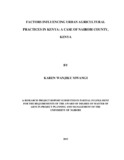| dc.description.abstract | Current global agricultural practices are recognized as unsustainable. The increase in overall human population as well as the global trend of rural to urban migration, partially as a result of historically and continual unsustainable agricultural practices, exacerbates the vicious cycle of poverty and hunger in developing countries. The global demand for food is projected to be 70% higher today.100, 000 people in the UK are estimated to be on waiting lists for allotments of land for urban agricultural practices (Foeken and Mwangi, 2000).The study therefore sought to examine the factors influencing urban agricultural practices in Nairobi Kenya. It is estimated that approximately 800 million people worldwide engage in urban agricultural practices, meaning agriculture located within or on the outskirts of towns or cities ( Nguthi, 2007) In Kenya, urban agricultural practices are widespread and are a well-established practice but not officially accepted by the central and local government officials. The study reviewed literature based on urban poverty, preference for fresh foods, food insecurity and population growth. The study employed a descriptive survey research design aimed at identifying the factors influencing urban agricultural practices in Nairobi Kenya. The study was done in Nairobi County which is Kenya's capital and largest city. The data for this research was collected using a survey questionnaire. The study used both primary and secondary data. The process of data analysis involved several stages: the completed questionnaires were edited for completeness and consistency, checked for errors and omissions. Qualitative data was sorted into themes, categories and patterns. This enabled the researcher to make general statements in terms of the observed attributes and conceptualization of the study. The study established that urban poverty in Nairobi County has highly contributed to increased urban agricultural practices poor families spend 60-80% of their income on food and still be are insecure, high urbanization without corresponding Agricultural practices in Nairobi County were positively associated with nutritional status in some income groups. Urban agricultural practices are one way to escape the food insecurity and poverty cycle and population growth. The study concludes that urban poverty (average mean 4.22), preference for fresh food (average mean 4.19), food insecurity (average mean 4.31) and population growth (average mean 4.34), all had a positive influence on urban agricultural practices and has resulted in an increase of these practices. The study recommends; for the County Government of Nairobi through Ministry of Agriculture to formulate policies that govern the practice of urban agriculture. Also that the government should be at the fore front in empowering urban dwellers on the benefits of urban green space, creating social frameworks to plan, implement and maintain these urban green space and create a process to balance the needs of those living in urban areas with the needs of the larger environmental concerns. | en_US |



